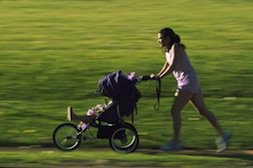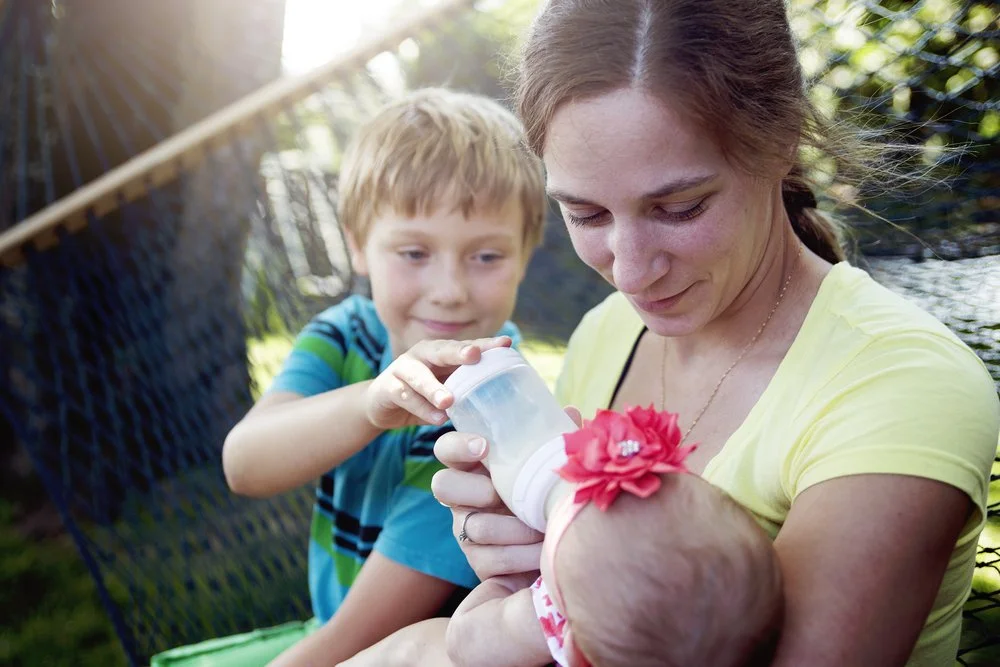My Postpartum Exercise Addiction
While losing my "baby weight," I nearly lost myself
Things started to fall apart on Labor Day 2001. I was nursing my moon-faced 8-month-old boy in our bedroom with the sun dappling blobs of light on the bedspread. It was one of those spectacularly beautiful San Francisco days with no fog. My 6-year-old daughter was quietly reading in her room, and my husband was organizing the kitchen. All seemed right in our little world.
Outside the window, I spied my upstairs neighbor unstacking plastic chairs for a barbecue that afternoon. He called up to ask if I was coming.
I like to imagine that I went to that barbecue, smiling my way through the crowd with my sweet baby draped over one shoulder, making small talk about how he was liking solid foods (banana yes, squash no) and how he was a tremendous sleeper (unlike his sister). Instead, that day I drew the shades and fell through the rabbit hole. And did not find my way out of it for nearly a year.
There was no way I was going to mingle with the sleek ponytailed girls with sun-kissed skin and lithe physiques untouched by the demands of pregnancy and birth. I was not going to parade my stretch-marked Jell-O belly through that crowd. I harbored 20 extra pounds, and my breasts vacillated between two states – engorged and leaky or drooping and leaky. I looked in the mirror and thought: Get it together!
Clearly, long walks with the baby in the stroller were not snapping me back into fighting shape. We had a family membership at a local fitness center, but I avoided going because it was right across the street from my old office, where I (and dozens of my co-workers) had become laid-off casualties of the dot-com meltdown. But my growing discontent about my body superseded that hang-up, and I went back to the gym. Little did I know that would lead to much more destructive problems.
I started with 30 minutes on the elliptical machine reading fitness magazines. The Spandex-clad exercisers in the photos became my strong and toned role models. It felt good to sweat and wake my sedentary body from dormancy. These lengthening workouts gave my days structure, which is hard to come by when you're a newly minted freelancer with two young children. Nothing in my life felt ordered and in control except for the numbers accruing quickly on the machine: calories burned, miles total.
I added 30-minute laps in the pool while my daughter took swim lessons. And because that still didn't feel like enough, I started running to the pool while my husband drove her there. When my husband was laid off too, I began running full-time. Two miles stretched to 3 1/2 miles to 6 miles – every single day. Some weeks I'd run 45 miles, easy. On rare occasions, I'd let myself slide down to 3 miles at a time, but only if I had a very good excuse – say, a 101-degree fever.
As I look back, it's pretty clear my "healthy" regimen was far from it. But that's not how it felt then. For every pound I lost, I'd get high-fives from friends who noticed my slimmer form. I was eating healthier too, passing up the fatty, lardy stuff in favor of whole grains and lean proteins.
What neither my friends nor I realized was that I was exercising to exorcise my fear. My husband and I were underemployed and raising two kids in an expensive city during a recession. I struggled with constant worry, so I fled from it. I ran until I was too tired to think. I swam until I was too tired to feel. And because I worked around my children's schedule and swapped workout times and kid duty with my husband, it seemed like a very manageable way to manage my anxiety. I thought I was fine, but I wasn't.
For one thing, the injuries were piling up. I ran with a strained ankle and plantar fasciitis – pain in the bottoms of my feet caused by inflamed soles. I lost so much weight that some months I didn't get my period. Close friends lamented that they never saw me anymore and suggested that maybe, just maybe, I was getting a little too thin. Swimming began to feel like work. I had to run at least 6 miles everyday to feel accomplished. Or else what? I didn't know, and I didn't want to find out. I just knew I'd feel antsy and anxious about not hitting my number that day. It had become an obsession.
According to Eating Disorder Hope, the symptoms of exercise addiction include: "avoiding social functions to exercise" (check), "continuing to exercise when injured or sick" (check), and "firmly adhering to an obsessive and regimented exercise regimen" (check).
Exercise addiction does, in fact, develop much like other addictions, according to neuroscientist and Johns Hopkins University professor David Linden. In his book, The Compass of Pleasure, he explains how it triggers the "pleasure circuit" of the brain and, when taken to the extreme, mimics the arc of other unhealthy compulsions. For instance, when you miss your workouts, you experience withdrawal symptoms, such as irritability and anxiety (check), much as a drug addict would.
A study published in the British Journal of Sports Medicine also found that endurance exercise, like long-distance running, increases the level of endocannabinoids in the body. These substances have an effect similar to the active ingredient in marijuana, creating that feeling many describe as a "runner's high." I'd become an addict.
I was a ripe candidate for it. I had suffered postpartum depression after the birth of my first child, and although it didn't return after my second child was born, I was vulnerable given my history and the added stress of job losses and the subsequent financial struggles. Overexercising was my way to cope, allowing me to avoid the stresses of my life – literally. When I was on the road running, I didn't have to deal with the bills and worries that awaited me at home. And it gave me a sense of control – at least over the number on the scale and the miles and hours I logged.
And then something unlikely saved me from my exercise addiction – training for a marathon. Desperate to infuse new meaning into my listless workouts, I signed up to help raise money for the Leukemia & Lymphoma Society by running the New York City Marathon.
At the free training sessions, we were repeatedly advised to follow a strict schedule that emphasized rest days. At first, I cheated and ran on the rest days too, but I worried I would injure myself and fail by not even making it to the starting line, let alone finishing 26.2 miles. I didn't want to let down the inspiring men, women, and children we were fundraising for, so I took Saturdays off and spent them with my family. Then I also gave myself a break on Tuesdays.
I'd previously seen a therapist during my bout of postpartum depression, so I knew how helpful it could be. I started seeing a therapist again and began identifying my unhealthy behaviors one by one. I thought I was exercising to have a healthy life, but instead I ended up running away from my life. And I missed me. So I stopped recording my workouts in a diary. I stopped doubling up on swim laps and runs.
Whenever I felt antsy about not exercising, I took the kids out, read a book, or talked to my husband – anything but suffering the blistering punishment of the treadmill. It took months (and a few relapses), but I finally journeyed back to a healthier, better life. And this time I wasn't counting the miles.











